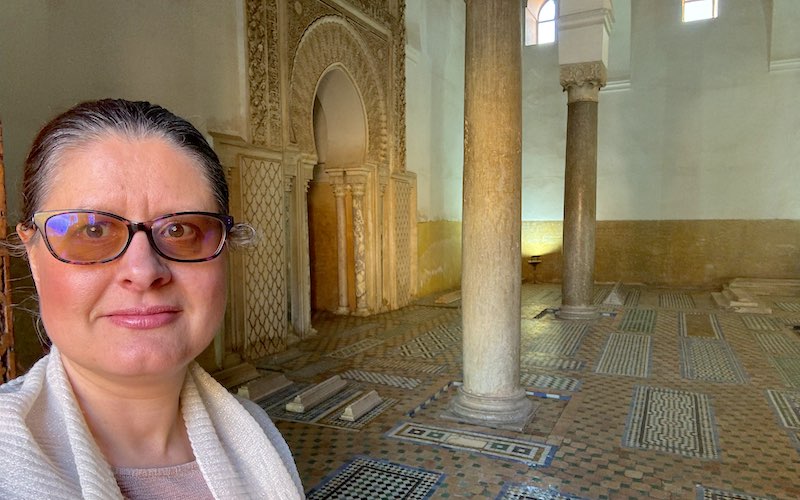Many people are eager to spend 3 days in Marrakech as it is a suitable long weekend destination if you are flying from Europe. Remember that Marrakech is not the capital of Morocco (that is Rabat), but it is the most historical and the most popular with tourists due to the amazing sightseeing. If you’re a first time visitor, you will be pleased to know that it’s a small enough city to spend 3 days there. Then, if you like it, you can then return at a later date for another visit, and maybe then spend more time exploring the Atlas Mountains and other popular destinations such as Essaouira, Fez and Chefchouen.
I’ve been to Marrakech four times now, and still want to find the time to go back for a fifth! That just shows you how captivating the city is. It is my favourite city in Morocco and actually, one of my favourite cities in the world! Before I go straight into an itinerary for 3 days in Marrakech, let’s first take a look at planning your trip.
Preparing to Visit Marrkech as a First Timer
Here are a few tips for planning your visit to Marrakech:
- Avoid going in the middle of the summer such as July and August, when it will be too hot.
- Spring (April and May) and Autumn (September and October) are great times to visit.
- When you fly into Marrakech, expect to pay around 100-150 Dirhams for an airport transfer to your Riad in the Medina. You can also pre-book your airport taxi here. This saves the stress of bartering when you have just got off the plane!
- Book a Riad within the Medina walls such as Dar Zaman or Dar Carina.
- Wear sturdy walking boots as there is a lot of walking to be done in Marrakech and there is some uneven ground.
- Pack light and comfortable clothes such as T-shirts, leggings and cotton or linen trousers.
- Dresses are OK if they are long and cover the shoulders – spaghetti straps, vest tops and low cut tops are not suitable for Marrakech.
- Sun hat, sun cream and a scarf or shawl are good to pack.
- Buy a good guide book such as the Lonely Planet Pocket Marrakech.
Where to Stay in Marrakech
I recommend staying in a Riad – a traditional Moroccan guest house with a courtyard. Most Riad’s in Marrakech offer mint tea reception and cooking classes/tours. I would definitely opt for a Riad over a hotel, because although there are many luxurious all inclusive hotels in Marrakech, you get a much more authentically Moroccan experience with a Riad.
I stayed at Riad Dar Zaman, where I was warmly welcomed by Hassan. The second trip I made to Morocco I stayed at Riad Carina and Riad Jardin de Lea.
Make sure that your Riad is within the Medina walls if possible, so that you are close to the main sites and the Souks. Location is important, particularly if you want to explore the city on foot. Riad Carina was the perfect location for exploring Bahia Palace and the Saadian tombs. Riad Dar Zaman was great for the Marrakech Museum.
3 Days in Marrakech Itinerary
So, you have 3 days inMarrakech and want to know how to spend it? Here is the ideal itinerary for a first time traveller….
- Day 1 – Marjorelle Gardens, Souks and Jmaa El Fna Square
- Day 2 – Koutubia Mosque, Bahia Palace and Saadian Tombs
- Day 3 – Marrakech Museum and Ben Yousef Madrasa (Old Quranic School)
3 days in marrakech – Day 1 – Marjorelle Gardens, Souks and Jmaa El Fna Square
On your first day in Morocco, it’s time to visit Koutubia Mosque and then head into the hustle and bustle of the souks and Jmaa El Fnaa, Marrakech’s most famous square.
Marjorelle Gardens
Head to Marjorelle Gardens first thing in the morning to see one of Marrakech’s most picturesque and instagrammable destinations. The garden is a one-hectare botanical garden and artist’s landscape garden, created by the French Orientalist artist Jacques Majorelle. It took around forty years to created, and construction in 1923. It also features a Cubist villa designed by French architect Paul Sinoir in the 1930s. It can get busy and sometimes fully booked in peak season, so it is a good idea to pre-order your entrance ticket here.
Souk Shopping
Next, head into the souks for a spot of shopping and prepare to get lost! You will see an amazing array of spices, arts and crafts. Remember to barter hard – it’s part of Moroccan culture. Just have fun with it and go with the flow! If you have something in mind that you would like to buy, it’s a good idea to ask the receptionist in your Riad roughly what you should be paying, so that you don’t pay over the odds. In the souk, you may experience people running after you down the street with products from their shop! Don’t be intimidated by this, just smile and have fun with them. You can simply say ‘no thank you’ if you don’t want to buy. Most shop owners in the souks speak Arabic, French and English.
Tips for visiting the souks:
- The souks are split into sections such as the handicrafts, textiles, spice souk and gold souk (jewellery).
- Barter hard if you want to buy.
- Get data on your mobile or download a map, but remember that not every small street will be on Google maps!
- Sometimes people will tell you ‘it’s closed!’ but you can ignore them because it usually means that they are trying to become your unofficial guide and rip you off!
- If you go into a carpet shop to look and show interest, and accept mint tea from the shop owner, you will be expected to buy something!
- Beware of scams where they say they will ship something for you (sometimes the rug or item never arrives or is the wrong one!) so it’s best to use a credit card with protection such as AMEX.
Souk Kafé
Looking for a good spot for lunch near Souk Semmarine? I recommend Souk Kafé, which has a reasonably priced selection of Moroccan salads, cous-cous and tagine. The roof terrace has great views of the city. Note that a service charge is added to the bill here, so you don’t need to pay an additional tip.
Jemaa el-Fnaa square
In the evening, head to Jemaa el-Fnaa square where you will be entertained by storytellers and snake charmers. For dinner, if you are feeling adventurous, eat from one of the night market stalls on the square – it’s tasty and sociable. All of the stall holders will be eager to tell you their stall number and what they serve!
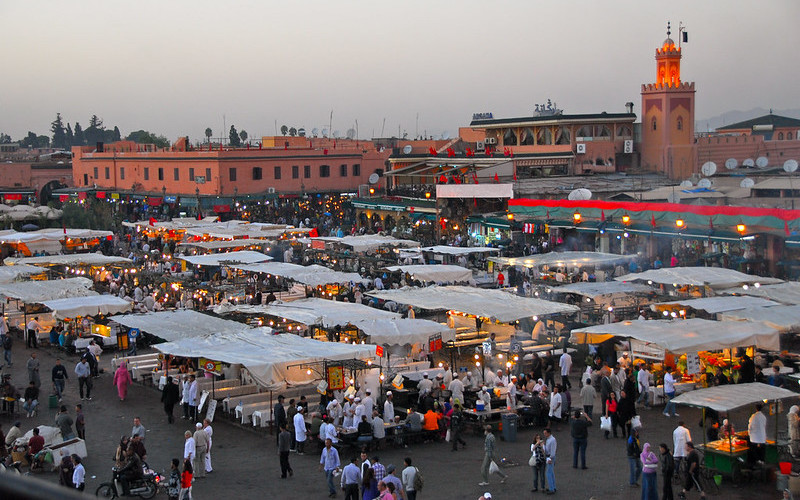
If you don’t want to head into the city alone, you can book one of the Marrakech tours. Advantages of the full day and half day tours are that you won’t get lost in the maze of streets, and also your guide will tell you a great deal about Moroccan history and religion.
3 days in marrakech – Day 2 – Koutubia Mosque, Bahia Palace and Saadian Tombs
Today you are going to experience three amazing sites of Marrakech – Koutubia Mosque, Bahia Palace and Saadian Tombs. I have done a video of Bahia Palace on YouTube, so if you would like to see it, click here. There are plenty of great places to eat and drink around Tinsmith Square, which is located inbetween these two historical sites and makes a great stop off point.
Koutubia Mosque
Visit Koutobia Mosque first thing in the morning on your second day. You won’t be able to enter if you are a non-Muslim, but it’s an impressive structure. Set off early in the morning to get good photos and avoid the heat of the day. As a tourist, you will be able to explore the courtyard and cemetary.
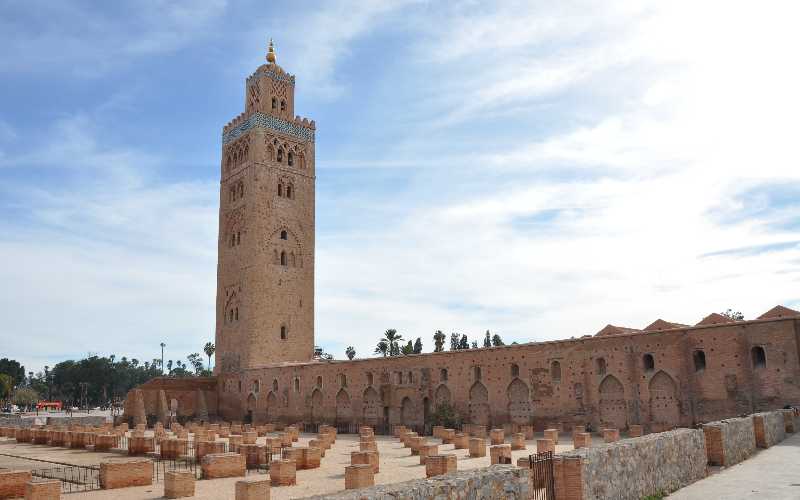
Bahia Palace
Visit Bahia Palace on your second day – a 160 room palace that will give a fantastic insight into Moroccan architecture. The palace was built in the late 19th century, during the rule of Grand Vizier Si Moussa, and later expanded by his son, Grand Vizier Ba Ahmed.
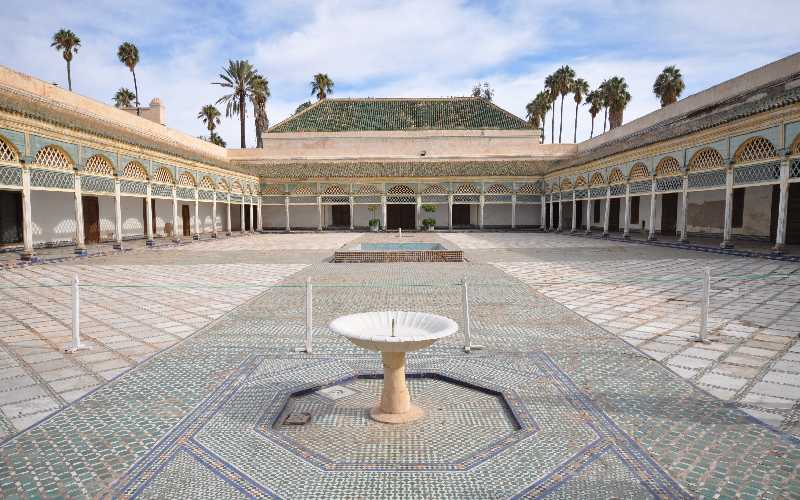
The name “Bahia” (pronounced bahee-a) translates to “brilliance,” and the palace truly lives up to its name with its opulent decorations and luxurious surroundings. It was intended to be one of the greatest palaces of its time, showcasing the wealth and power of the ruling elite.
Bahia Palace is a sprawling complex, covering several acres, and consists of a series of ornate rooms, courtyards, gardens, and pavilions. Its architecture reflects a blend of Islamic and Moroccan styles, featuring intricately carved wooden ceilings, colorful tiles, stucco work, marble floors, and delicately painted ceilings.
One of the most remarkable features of the palace is its beautiful gardens, which are adorned with citrus trees, exotic plants, fountains, and tranquil courtyards. These gardens provide a peaceful oasis amidst the bustling city of Marrakech. Note that there was some renovation work going on in one of the gardens when I visited in December 2023, but it did not obscure the views too much – the photographs still came out great!
Visitors to the Bahia Palace can explore its various rooms, including the Grand Courtyard, the Council Chamber, the Grand Reception Hall, the Harem Courtyard, and the apartments of the former residents. Many of these rooms are decorated with elaborate mosaics, carved plasterwork, and intricate woodwork.
The cost of visiting Bahia Palace at the time of writing (March 2023) was 70 Dirhams. You don’t need to book in advance, but it’s a good idea to get there early in the morning to miss the crowds. Again, ignore the boys or men on and near the gate who will tell you ‘it’s closed’ – they are probably lying or trying to distract you!
Badii Palace
If you have time and energy, you may be able to fit in a visit to Badi Palace, as it is close by. The palace was constructed to commemorate the victory of Sultan Ahmad al-Mansur over the Portuguese in the Battle of the Three Kings in 1578. It was designed to be one of the most lavish palaces of its time, with vast courtyards, ornate gardens, and luxurious pavilions.
However, despite its opulence, the Badi Palace’s glory was relatively short-lived. It fell into decline after the death of Sultan Ahmad al-Mansur in 1603 and was later stripped of its riches by subsequent rulers, most notably Moulay Ismail, who used the materials to embellish his own palace in Meknes.
It’s now not more than a picturesque a ruin, so if you are time limited, you can opt to miss this one out. Entrance fee at the time of writing (January 2024) was 70 Dirhams (MAD).
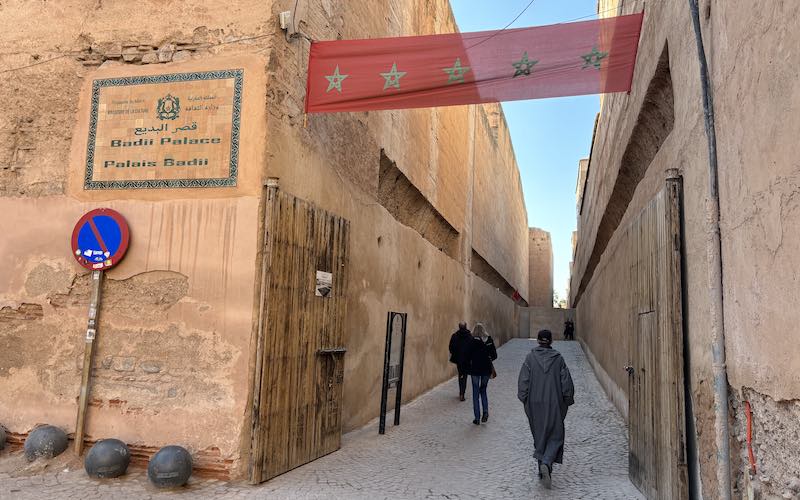
Lunch at Dar Touareg
A great place to go for lunch after Bahia Palace is Cafe Restaurant Dar Touareg. They do a brilliant set menu for around 150 Dirhams, with Moroccan salad, tagine, fruit and dessert! The lemon chicken is gorgeous, and they have a roof terrace with nice views of the city.
Saadian Tombs
After lunch, head to the Saadian tombs on foot, they are just a 10-15 minute walk from Bahia Palace/Tinsmith Square. The price of a ticket is currently 60 Dirhams (January 2024). Half an hour to an hour is sufficient to explore this historical site. Be prepared for a narrow and dark cave-like entrance! Also, beware that there are a lot of cats and kittens – although cute, it’s not advised to pet them due to the potential of rabies (the risk of this is even higher in dogs in Marrakech). Also, don’t let the guys at the entrance put snakes on you – it will surely cost a hefty price for a photo!
The tombs date back to the Saadian dynasty, which ruled Morocco from the late 16th century to the early 17th century. They were originally constructed by Sultan Ahmed al-Mansur al-Dhahabi, one of the most notable rulers of the Saadian dynasty, as a burial ground for himself and his family. The site was later abandoned and forgotten until it was rediscovered in 1917 during a French aerial survey of the city.
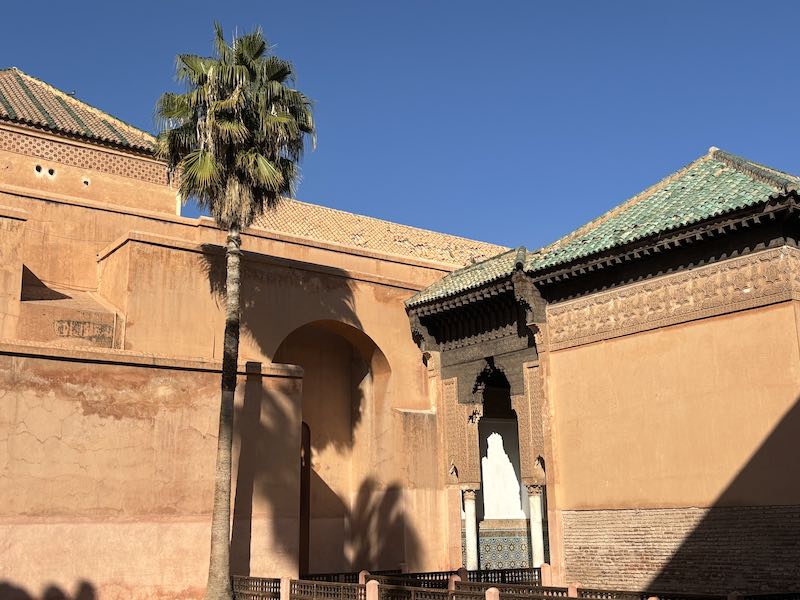
The Saadian Tombs consist of two main mausoleums: the mausoleum of Sultan Ahmed al-Mansur and the mausoleum of his successor, Sultan Moulay Ismail. These mausoleums contain the remains of several members of the Saadian dynasty, including sultans, princes, and other prominent figures.
The architecture of the Saadian Tombs is notable for its intricate decoration and fine craftsmanship. The mausoleums feature beautifully carved cedar wood ceilings, colorful tiles, marble columns, and ornate stucco work. The walls are adorned with intricate geometric patterns and inscriptions from the Quran.
One of the most famous features of the Saadian Tombs is the Hall of Twelve Columns, which is located in the mausoleum of Sultan Ahmed al-Mansur. This hall is named for its twelve marble columns and is considered one of the finest examples of Saadian architecture.
Mellah (Jewish Quarter) with Synagogue and Jewish Cemetary
If you still have time and energy, and are looking for more things to do on your second day, then it is convenient to explore Mellah on foot, which is the old Jewish quarter. You will find ‘Cementerio Judio’ which is the largest Jewish cemetary in Morocco. You may also find time to visit The Slat al-Azama Synagogue.
Dinner at Kozy Bar on TinSmith Square
Dinner and Drinks – For dinner and drinks on the evening after visiting the palace and tombs, head to Tinsmith Square. My favourite place to eat and drink here is Kozy Bar, which has fantastic goats cheese parcels that I must recommend! They have an extensive cocktail list and fantastic service, with a roof terrace that offers a gorgeous view of the Marrakech sunset.
You could also opt to drink a mint tea at your Riad before heading out for the evening to do a cooking class or watch some traditional Moroccan dancing.
3 days in marrakech – Day 3 – Marrakech Museum and Ben Yousef Madrasa
Today, you will see two stunning historical sites in the North of the city – Marrakech Museum and Ben Yousef Madrasa, the Old Quaranic school. These two sites are very close to each other and it’s easy tp walk. However, if you are staying in the South of the city, you might like to jump in a taxi to get to the Marrakech Museum. Remember that you don’t need to pay more than around 30-50 Dirhams for a taxi within the Marrakech Medina.
Marrakech Museum
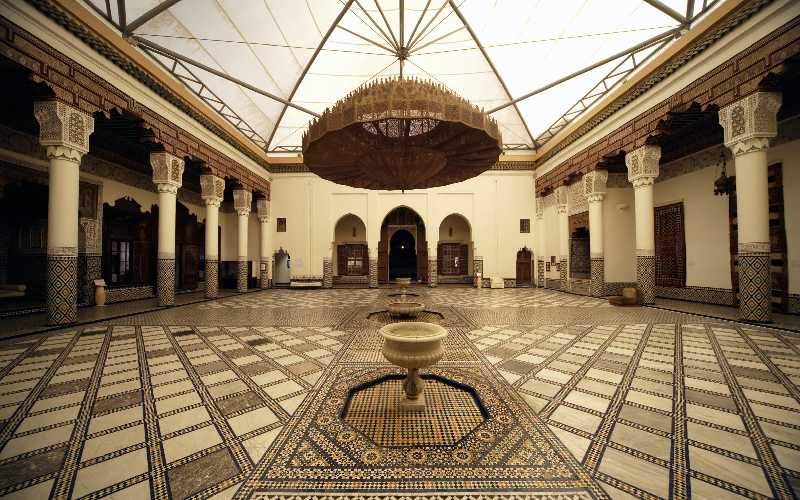
In the morning, go to the Marrakech Museum to explore a collection of ancient artefacts, instruments and art. The Marrakech Museum is housed in the Dar Menebhi Palace, an exquisite example of traditional Moroccan architecture built in the late 19th century. The intricate tile work, carved plaster, and ornate wooden ceilings, provides a fitting backdrop for the museum’s exhibits. Visitors can explore the palace’s elaborately decorated rooms, courtyards, and gardens while admiring the craftsmanship and beauty of Moroccan architecture. It is worth visiting for the architecture of the building alone!
The museum historical and artefacts and objects in the Marrakech Museum highlight the cultural heritage and artistic traditions of Marrakech and Morocco as a whole. The exhibits encompass various themes, including Islamic art, Moroccan textiles, ceramics, jewelry, calligraphy, and traditional Moroccan costumes.
In addition to its permanent collection, the Marrakech Museum also hosts temporary exhibitions, cultural events, and educational programs aimed at promoting an understanding and appreciation of Moroccan art and culture. These activities contribute to the museum’s role as a hub for cultural exchange and dialogue in Marrakech.
It’s a short walk to Ben Yousef Madrasa. If you need directions, ask at the museum or in a shop – don’t follow the ‘boys’ outside the Marrakech Museum – it will certainly cost you and some can become verbally aggressive.
Ben Yousef Madrasa
Just around the corner and not to be missed in Marrakech is Ben Yousef Madrasa, the Old Quranic school. This is my favourite thing to do in Marrakech. The price for a ticket at the time of writing was 50 Dirhams (January 2024).
The madrasa was founded in the 14th century and was named after the Almoravid sultan Ali ibn Yusuf (reigned 1106–1142) who expanded the city of Marrakech and its influence. It served as an educational institution for Islamic scholars, teaching subjects such as theology, law, mathematics, and astronomy. It also served as a center for Quranic studies and religious education.
Architecturally, the Ben Youssef Madrasa is renowned for its stunning Islamic design and intricate decoration. Its courtyard is adorned with intricate stucco work, carved cedar wood, and colorful mosaic tiles, showcasing the exquisite craftsmanship of Moroccan artisans.
Dinner at Le Jardin
Go to ‘Le Jardin’ for lunch on your first day, to try a tasty Moroccan meal such as a Moroccan salad or couscous. The setting is a beautiful garden oasis in the courtyard of a 16th Century building, decorated with stunning Moroccan tiles. They also have several European and American options, plus an AMAZING creme brulee!
What to pack for 3 days in Marrakech
Finally, what should you pack for a perfect 3 days in Marrakech? Of course you want to pack your travel documentation including passport and tickets, and main clothing and toiletries. But additionally, here are a few things that I really recommend to consider when packing for Marrakech….
- Cash money to change at the Money Exchange (not everywhere accepts card).
- VISA or AMEX Credit card and Debit card – these worked with contactless in Marrakech in numerous bars and restaurants.
- Conservative clothing – a pair of jeans, linen pants and several pairs of cotton T shirts and leggings.
- A scarf or shawl to be used to cover your head and shoulders if necessary and also to keep you warm on cooler nights.
- A base layer such as a long sleeved thermal top – mine is from Regatta. A comfortable fleece to layer up in the evening – – mine is a zip down fleece from Tog 24.
- Warm pyjamas, especially if you are travelling during the winter as nights can get much cooler than expected.
- Comfortable walking boots and walking socks – there is a lot of ground to cover!
- Vaseline and lip balm or lip salve – the dry conditions in Marrakech in summer can be harsh on your skin and lips.
- Plug converter – for the two pin plug (also used in Spain and Portugal).
- Lonely Planet Morocco – It is nice to have something physical to flick through and read when you are relaxing in your hotel or waiting around for transport connections.
If you are lucky enough to have a little longer to spend in Morocco, why not consider a trip across the Atlas Mountains to Ouarzazate and Ait Benhaddou (kasbah). If you are a surfer, you may want to head to one of the coastal towns such as Essouira.
Further Reading on 3 days in Marrakech
I hope that you enjoyed my blog on how to spend 3 days in Marrakech. If you would like to see some of my videos on Morocco, please head of to my YouTube channel: https://www.youtube.com/@TempleSeeker
You might also like to read the following blogs….
- Marrakech in December
- Things to do in Marrakech
- What to pack for Morocco
- Is Marrakech worth visiting?
- Morocco ultimate solo female travel guide
And finally, if you are more limited on time, then you might find this 2 day Marrakech itinerary helpful.

